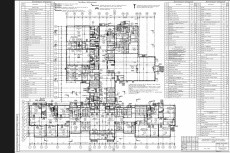Finally, we can add a few things to finish our plan, like putting vegetation around the cabin. We can simply copy a few trees from our imported DXF drawing and scale them down with the tool, to for example (0.5,0.5). We can also change the line thickness of a couple of objects, for example make the walls thicker, and change the color of some things. And we can organize all our elements in groups. The ability to organize your work in nested groups is surely one of the big advantages of groups over traditional work with layers. In this tutorial, I grouped my objects by type, inside the Plan group.
For example, instead of having one big layer with all dimensions of your drawing, each part of the drawing will contain their own dimensions group, making it extremely easy to organize your drawing. You might feel a loss at first if you come from a traditional drawing program like AutoCAD, but you'll quickly see the power that this method brings. For example, all our construction geometry can go in a separate group, that we'll turn off. Maybe later we'll need to make some changes, and it will be handy to have that geometry available. So, now we are ready to draw other parts.
Both DWG and DXF are vector graphic file formats. Vector images maintain the same image quality at practically any scale, making them perfect for design purposes. It’s also easy to edit the individual elements that form a vector image, as well as adding or removing elements.

Drawing the elevations. Full dvd downloads. Since in this exercise we are going to stay in pure 2D, we will draw our elevations and sections directly. In more advanced architecture environments (what FreeCAD will hopefully become in some future), we wouldn't need to draw the elevations. We would model the building in 3D and then generate the different views automatically. But for the sake of this exercise (and also because all the needed tools are still not implemented in FreeCAD), we'll do it by hand, like in the old times. We'll begin with the rear wall elevation, because the way our plan is oriented, it can be drawn directly below it, without the need to rotate the view.
We will simply draw construction lines from the plan, set horizontal lines to the desired heights, I set the 0.00 level, the +0.15 level of the slab, then heights for the windows, and the roof slab at +2.50. We can then draw our geometry very quickly on top of it. We can then place a couple of annotations, dimensions, and upgrade some of the objects so they appear filled with a color. Finally, we can make a bit of cleaning by creating a 'South Elevation' group, then subgroups for our construction geometry and annotations, and place all of our new objects in them.

Rotating the view, and creating macros Now, we need to draw other elevations of our little building. The simplest way would be to draw them directly under the plan view, as we did with the south elevation. For this, it would be handy to be able to rotate the view by 90°, so we can continue drawing our elevations 'on foot'. Unfortunately, FreeCAD has at the moment no 'Rotate View' tool. But, fortunately, it has tools for us to easily create our own tools, called Macros. So, this is a good opportunity for us to try something easy.